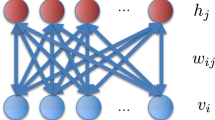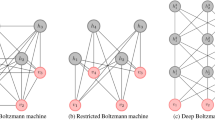Abstract
This article proposes a new annealing algorithm for Boltzmann machines. This algorithm uses an exponential formula for temperature scheduling that produces remarkably better solutions for global optimization. The superiority of the new algorithm is shown by computer simulations of several examples on the Boltzmann machine and its variants. The new algorithm is also shown to have better properties compared to the Generalized Simulated Annealing (GSA) and other similar algorithms.
Similar content being viewed by others
Explore related subjects
Discover the latest articles, news and stories from top researchers in related subjects.References
E.H.L. Aarts and J.H.M. Korst,Simulated Annealing and Boltzmann Machines: A Stochastic Approach to Combinatorial Optimization and Neural Computing, John Wiley & Sons: New York, 1989.
G.E. Hinton and T.J. Sejnowski, “Learning and relearning in Boltzmann machines,” inParallel Distributed Processing: Explorations in the Microstructure of Cognition, edited by J.L. McClelland and D.E. Rumelhart, MIT Press: Cambridge, MA. pp. 282–317. 1986.
P. Smolensky. “Information processing in dynamical systems: Foundations of harmony theory,” inParallel Distributed Processing: Explorations in the Microstructure of Cognition, edited by J.L. McClelland and D.E. Rumelhart, MIT Press: Cambridge, MA. pp. 194–281, 1986.
L. Xu, “An improvement on simulated Annealing and Boltzmann Machine,”Proc. IJCNN90, vol. 1. pp. 1341–1344. January 1990.
J.J. Hopfield, “Neural networks and physical systems with emergent collective computational abilities,”Proc. Natl. Acad. Sci. USA, vol. 79, pp. 2554–2558. 1982.
J.L. McClelland and D.E. Rumelhart, “Constraint satisfaction in PDP systems,” inExplorations in Parallel Distributed Processing, A Handbook of Models, Programs, and Exercises, MIT Press, Cambridge, MA, pp. 49–81, 1988.
S. Geman and D. Geman, “Stochastic relaxation, Gibbs distributions and the Baysian restoration of images.”IEEE Trans. Pattern Anal. Machine Intell., vol. 6, pp. 721–741, 1984.
H. Szu, “Fast simulated annealing.”Neural Networks Conf. Proc. AIP, vol. 151, pp. 420–425, 1986.
I. Bohachevsky, M. Johnson, and M. Stein, “Generalized simulated annealing for function optimization,”Technometrics, vol. 28, no. 3, pp. 209–217, 1986.
C.S. Enrique and C.F. Bruno, “Self learning simulated annealing.”Proc. IJCNN90, vol. 1, pp. 1463–1467. January 1990.
R. Richards. “An efficient algorithm for annealing schedules in Boltzmann machines,”Proc. IJCNN90, vol. 1, pp. 1309–1312, January 1990.
Author information
Authors and Affiliations
Rights and permissions
About this article
Cite this article
Ansari, N., Sarasa, R. & Wang, G. An efficient annealing algorithm for global optimization in Boltzmann machines. Appl Intell 3, 177–192 (1993). https://doi.org/10.1007/BF00871936
Issue Date:
DOI: https://doi.org/10.1007/BF00871936




